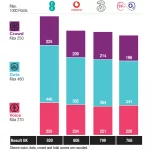Welsh Government Take Flak Over Delay to New Broadband Contract
The Conservative AM for Montgomeryshire in Wales, Russell George, has criticised the Welsh Government’s lack of explanation over the delay in awarding contracts for their new “superfast broadband” (30Mbps+) roll-out project, which aims to reach 88,000 extra premises in poorly served areas and could be worth up to £200m.
At present almost 95% of homes and businesses across Wales are already estimated to be within reach of a superfast network, which is partly due to the original Superfast Cymru programme with Openreach (BT) that has worked to extend the reach of fibre-based FTTC and FTTP ISP technologies to 733,000 premises (here). This contract has now ended.
By comparison the new Phase 2 follow-on scheme, which was put out to tender at the very start of 2018 (here and here), aims to extend 30Mbps+ capable networks to “every property” in Wales (with a focus on FTTP “full fibre” connectivity). Originally the completion date for this phase was pegged as the end of 2020, which wasn’t particularly realistic and the WG has since stopped using it.
Advertisement
The potential value of this new project is up to £200m, although the first tender document only confirmed about £62.5m of that total and is initially targeting an expansion to around 88,000 additional homes and businesses. The investment will be split across three lots and these don’t necessarily have to be won by the same supplier.
Lot 1 — North West Wales (Estimated value: £14.858m)
Intervention Area of 21,125 NGA white premises has been identified with an additional 29820 premises potentially available pending further information.Lot 2 — East Wales (Estimated value: £21.706m)
Intervention Area of 30,862 NGA white premises has been identified with an additional 21183 premises potentially available pending further information.Lot 3 — South West Wales (Estimated value: £25.436m)
Intervention Area of 36,166 NGA white premises has been identified with an additional 17552 premises potentially available pending further information.
Back in May 2018 Julie James AM, Leader of the House and Chief Whip, issued an update on the progress of Phase 2 and pledged to “announce the successful bidders before the summer recess, with deployment work commencing as swiftly as possible after that.”
The summer recess has now begun and today a report by the BBC quotes Ms James as saying that their procurement process has been “complex with a number of unforeseen issues arising,” which she pledged to elaborate on in the coming weeks.
A Spokesperson for the Welsh Government said:
“While Superfast Cymru has successfully changed the digital landscape in Wales, we know there is more to do in reaching the remaining premises without access and we are now working on how to do this.
A tender process is under way for the successor scheme to Superfast Cymru, which will be underpinned by significant amounts of public funding, and further details will be provided in the autumn.
Work on the procurement exercise is complex and we will award contracts as quickly as the process allows. It is absolutely essential and right that time is taken on this so the full benefits from the successor scheme can be achieved.”
In fairness complex procurements like this often tend to take longer than expected and we’ve seen the same sort of delays in a large number of other broadband delivery contracts across the UK (what really matters is the end result). As such we tend not to get too worried unless the process drags on for several months past the target without a clear conclusion.
Advertisement
Equally with so much money on the table there’s always the prospect of a possible dispute between prospective suppliers, which is an issue that seems to currently be afflicting the Scottish Government’s similar £600m tender (here). However at the time of writing we’ve no evidence to suggest that the same type of dispute may be causing problems in Wales.
Instead we suspect that the challenge of maximising value vs coverage in such an inherently sparse and rural part of Wales, which will be expensive to reach with FTTP, could be making it difficult to get the finer details agreed with prospective suppliers. The problems that Openreach faced with their FTTP roll-out during Phase 1 (wayleave issues etc.), some of which have been left unfinished, helps to highlight that challenge.
Mark is a professional technology writer, IT consultant and computer engineer from Dorset (England), he also founded ISPreview in 1999 and enjoys analysing the latest telecoms and broadband developments. Find me on X (Twitter), Mastodon, Facebook, BlueSky, Threads.net and Linkedin.
« Richard Tang to Step Down as CEO of UK ISP Zen Internet


















































Comments are closed